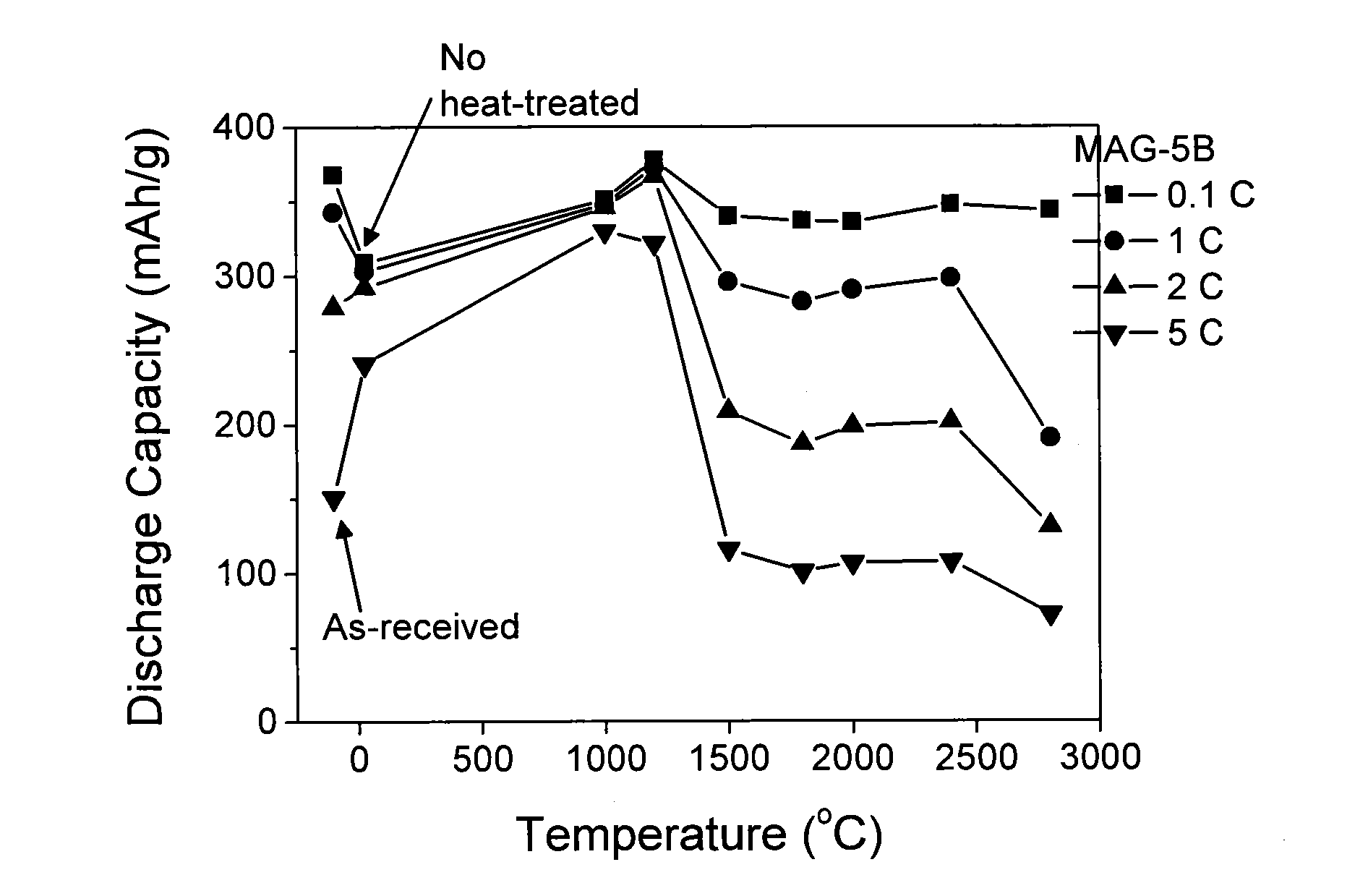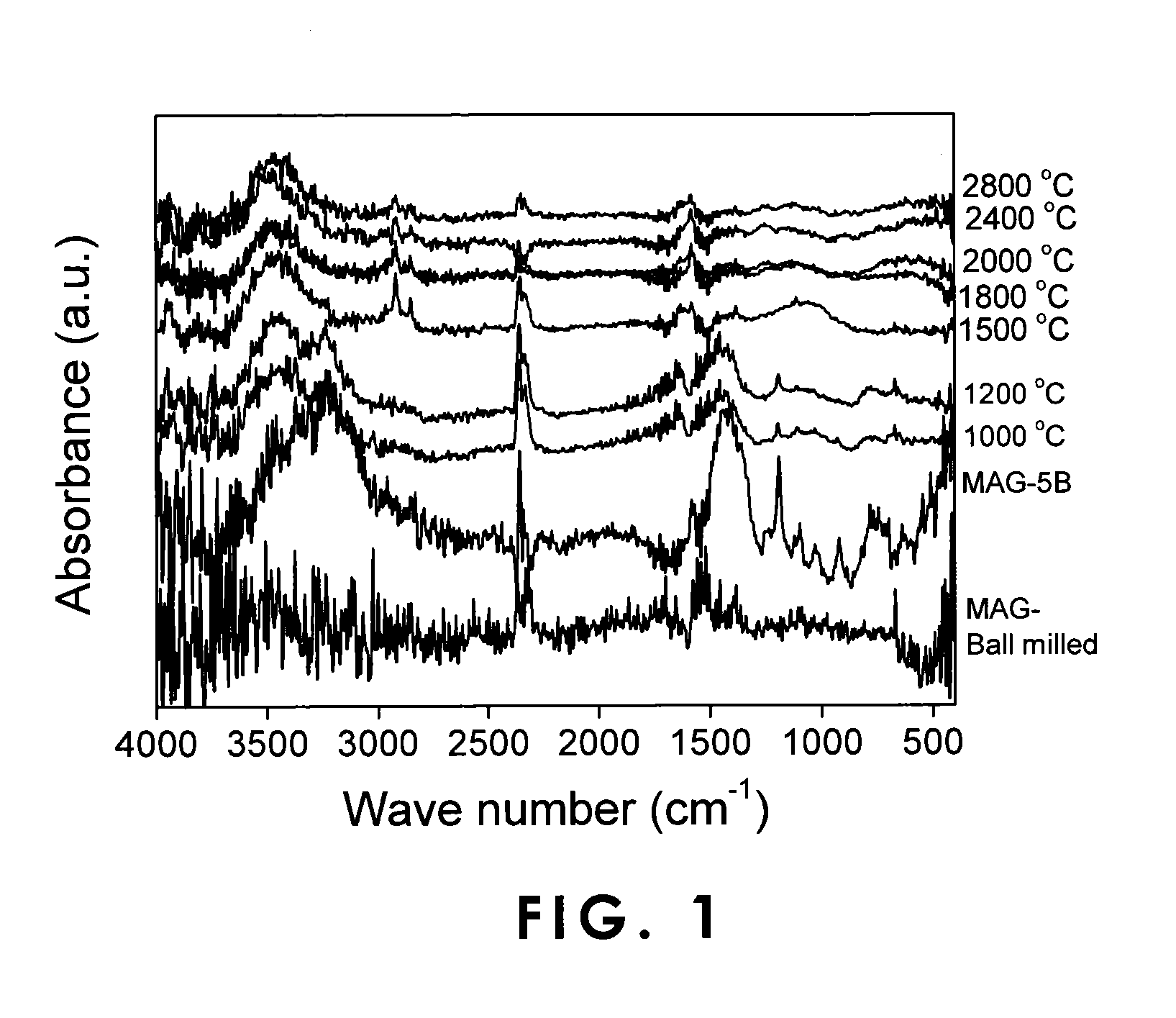Negative-electrode material for rechargeable batteries with nonaqueous electrolyte, and process for producing the same
a technology of negative electrodes and electrolyte, which is applied in the direction of cell components, final product manufacturing, sustainable manufacturing/processing, etc., can solve the problem of considerably lower discharge capacity and achieve excellent rate characteristics and high charge and discharge capacity
- Summary
- Abstract
- Description
- Claims
- Application Information
AI Technical Summary
Benefits of technology
Problems solved by technology
Method used
Image
Examples
example 1
Negative-Electrode Material Using Natural Graphite
[0053]A product obtained by adding boric acid (manufactured by Sigma-Aldrich Co.) to a natural graphite having a carbon atom content of not less than 99.995% in terms of mass and a lattice spacing (d002) of 3.354 angstroms in the C-axis direction and kneading the mixture in a ball mill was heat-treated for doping with boron. Boron doping amount was 5% in terms of the mass of the boron atom based on the natural graphite. The natural graphite mixed with boric acid was heat-treated at 200° C., 300° C., 500° C., 1000° C., 1200° C., 1500° C., 1800° C., 2000° C., 2400° C., and 2800° C. to obtain negative-electrode materials. Separately, a mixture was prepared in the same manner as described above, except that the addition amount of boric acid was 3% in terms of the atomic mass of boron. The mixture was heat-treated at 1000° C. and 1200° C. to obtain negative-electrode materials.
[0054]For the negative-electrode materials thus obtained, infr...
example 2
Negative-Electrode Material Using Artificial Graphite
[0060]An artificial graphite was obtained by heat-treating green coke (proportion of optical isotropic structure: not more than 25%) at 2800° C. The artificial graphite (HDPC) thus obtained had a carbon content of 99.90% and a lattice spacing (d002) of 3.369 angstroms in the C-axis direction.
[0061]Boric acid (manufactured by Sigma-Aldrich Co.) was added in an amount of 3% in terms of the mass of boron atom to the artificial graphite, and the mixture was kneaded in a ball mill. In the same manner as in Example 1, the artificial graphite with boric acid mixed thereinto was heat-treated at 1000° C., 1200° C., 1500° C., 1800° C., 2000° C., 2400° C., and 2800° C. to obtain negative-electrode materials.
[0062]For the negative-electrode materials thus obtained, infrared spectral characteristics were measured with a Fourier transformation infrared spectrophotometer (FT-IR MB-series, manufactured by ABB Bomen Inc.). The results were as show...
example 3
Negative-Electrode Material Using Natural Graphite
[0066]A product obtained by adding boric acid (manufactured by Sigma-Aldrich Co.) to a natural graphite having a carbon atom content of not less than 99.95% in terms of mass and a lattice spacing (d002) of 3.361 angstroms in the C-axis direction and kneading the mixture in a ball mill was heat-treated for doping with boron. Boron doping amount was 3% in terms of the mass of boron atom based on the natural graphite. The natural graphite with boric acid mixed thereinto was heat-treated at 1000° C. and 2800° C. to obtain negative-electrode materials.
[0067]Coin-type rechargeable batteries were prepared by preparing a working electrode from the negative-electrode material, preparing a counter electrode (CE) and a reference electrode (RE) from lithium metal, and using, as an electrolysis solution, a solution prepared by dissolving LiPF6 as an electrolyte salt in a mixed solvent composed of ethylene carbonate and dimethyl carbonate at a rat...
PUM
| Property | Measurement | Unit |
|---|---|---|
| lattice spacing | aaaaa | aaaaa |
| temperature | aaaaa | aaaaa |
| temperature | aaaaa | aaaaa |
Abstract
Description
Claims
Application Information
 Login to View More
Login to View More - R&D
- Intellectual Property
- Life Sciences
- Materials
- Tech Scout
- Unparalleled Data Quality
- Higher Quality Content
- 60% Fewer Hallucinations
Browse by: Latest US Patents, China's latest patents, Technical Efficacy Thesaurus, Application Domain, Technology Topic, Popular Technical Reports.
© 2025 PatSnap. All rights reserved.Legal|Privacy policy|Modern Slavery Act Transparency Statement|Sitemap|About US| Contact US: help@patsnap.com



